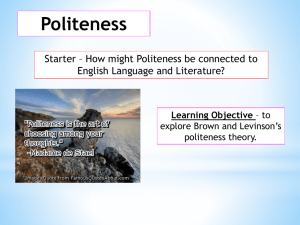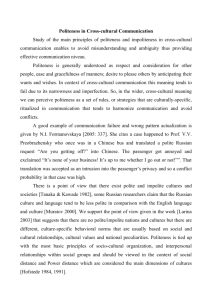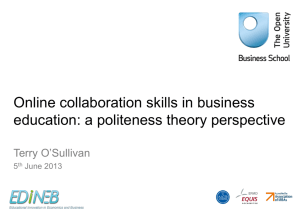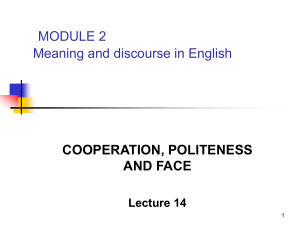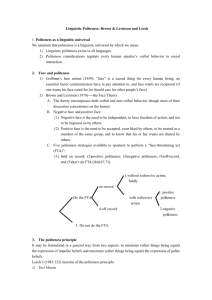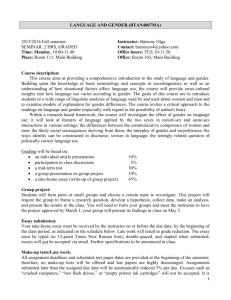Using a Shared Representation to Generate Action and Social Language
advertisement
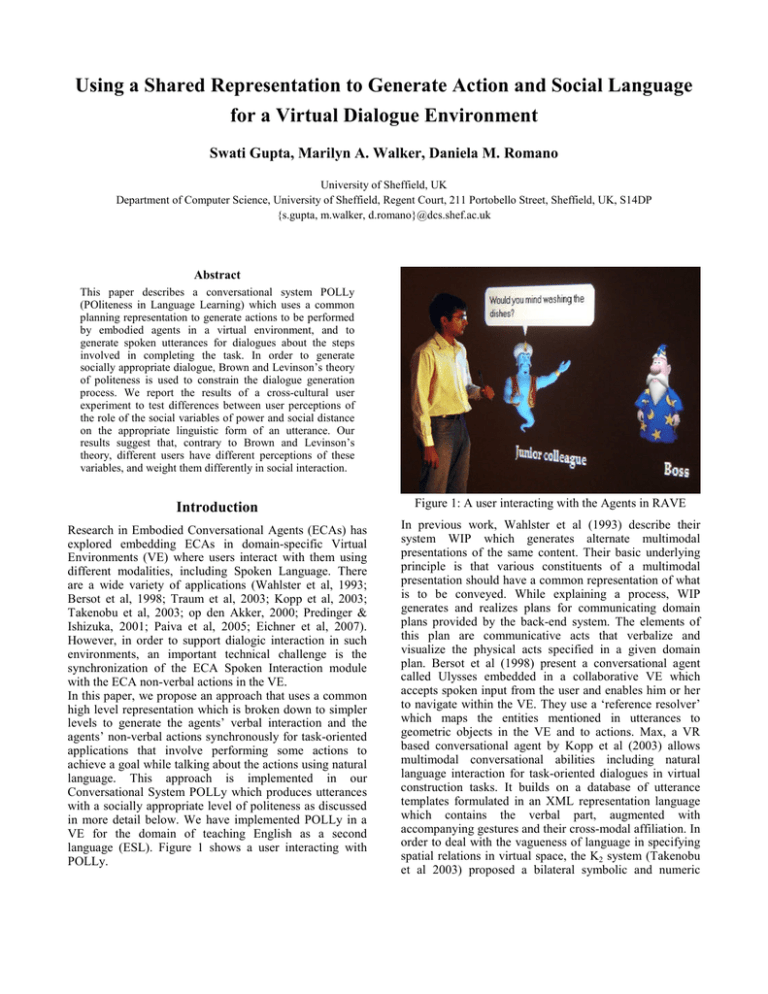
Using a Shared Representation to Generate Action and Social Language
for a Virtual Dialogue Environment
Swati Gupta, Marilyn A. Walker, Daniela M. Romano
University of Sheffield, UK
Department of Computer Science, University of Sheffield, Regent Court, 211 Portobello Street, Sheffield, UK, S14DP
{s.gupta, m.walker, d.romano}@dcs.shef.ac.uk
Abstract
This paper describes a conversational system POLLy
(POliteness in Language Learning) which uses a common
planning representation to generate actions to be performed
by embodied agents in a virtual environment, and to
generate spoken utterances for dialogues about the steps
involved in completing the task. In order to generate
socially appropriate dialogue, Brown and Levinson’s theory
of politeness is used to constrain the dialogue generation
process. We report the results of a cross-cultural user
experiment to test differences between user perceptions of
the role of the social variables of power and social distance
on the appropriate linguistic form of an utterance. Our
results suggest that, contrary to Brown and Levinson’s
theory, different users have different perceptions of these
variables, and weight them differently in social interaction.
Introduction
Figure 1: A user interacting with the Agents in RAVE
Research in Embodied Conversational Agents (ECAs) has
explored embedding ECAs in domain-specific Virtual
Environments (VE) where users interact with them using
different modalities, including Spoken Language. There
are a wide variety of applications (Wahlster et al, 1993;
Bersot et al, 1998; Traum et al, 2003; Kopp et al, 2003;
Takenobu et al, 2003; op den Akker, 2000; Predinger &
Ishizuka, 2001; Paiva et al, 2005; Eichner et al, 2007).
However, in order to support dialogic interaction in such
environments, an important technical challenge is the
synchronization of the ECA Spoken Interaction module
with the ECA non-verbal actions in the VE.
In this paper, we propose an approach that uses a common
high level representation which is broken down to simpler
levels to generate the agents’ verbal interaction and the
agents’ non-verbal actions synchronously for task-oriented
applications that involve performing some actions to
achieve a goal while talking about the actions using natural
language. This approach is implemented in our
Conversational System POLLy which produces utterances
with a socially appropriate level of politeness as discussed
in more detail below. We have implemented POLLy in a
VE for the domain of teaching English as a second
language (ESL). Figure 1 shows a user interacting with
POLLy.
In previous work, Wahlster et al (1993) describe their
system WIP which generates alternate multimodal
presentations of the same content. Their basic underlying
principle is that various constituents of a multimodal
presentation should have a common representation of what
is to be conveyed. While explaining a process, WIP
generates and realizes plans for communicating domain
plans provided by the back-end system. The elements of
this plan are communicative acts that verbalize and
visualize the physical acts specified in a given domain
plan. Bersot et al (1998) present a conversational agent
called Ulysses embedded in a collaborative VE which
accepts spoken input from the user and enables him or her
to navigate within the VE. They use a ‘reference resolver’
which maps the entities mentioned in utterances to
geometric objects in the VE and to actions. Max, a VR
based conversational agent by Kopp et al (2003) allows
multimodal conversational abilities including natural
language interaction for task-oriented dialogues in virtual
construction tasks. It builds on a database of utterance
templates formulated in an XML representation language
which contains the verbal part, augmented with
accompanying gestures and their cross-modal affiliation. In
order to deal with the vagueness of language in specifying
spatial relations in virtual space, the K2 system (Takenobu
et al 2003) proposed a bilateral symbolic and numeric
Figure 2: POLLY’s Architecture
representation of locations, to bridge the gap between
language processing (a symbolic system), and animation
generation (a continuous system). K2 extracts a user’s goal
from the utterance and translates it into animation data.
The FearNot! demonstrator by Paiva et al (2005) provides
training to kids against bullying via virtual drama in which
one virtual character plays the role of a bully and the other
plays the role of victim, who asks the child for advice. The
advice modifies the character’s emotional state and affects
its behaviour in the next episode. FearNot!’s spoken
interaction is template-based. In case of interaction
between the child and the character, the incoming text is
matched against a set of language templates. The
information about the character’s action is defined in a
collection which contains the utterance to be spoken as
well as the animation. Eichner et al (2007) describe an
application in which life-like characters present MP3
players in a virtual showroom. An XML scripting language
is used to define the content of the presentation as well as
the animations of the agents.
Since these ECAs function in scenarios where they interact
with the world, other agents, and the user, they must be
‘socially intelligent’ (Dautenhahn, 2000) and exhibit social
skills. Our work is based on the hypothesis that the
relevant social skills include the ability to communicate
appropriately, according to the social situation, by building
on theories about the norms of human social behaviour.
We believe that an integral part of such skills is the correct
use of politeness (Brown & Levinson, 1987; Walker et al
1997). For instance, note the difference in the effect of
requesting the hearer to clean the floor by saying ‘You
must clean the spill on the floor now!’ and ‘I know I’m
asking you for a big favour but could you kindly clean the
spill on the floor?’
According to Brown and Levinson (1987) (henceforth
B&L), choices of these different forms are driven by
sociological norms among human speakers. Walker et al
(1997) were the first to propose and implement B&L’s
theory in ECAs to provide interesting variations of
character and personality in an interactive narrative
application. Since then B&L’s theory has been used in
many conversational applications e.g. animated
presentation teams (André et al 2000; Rehm & André,
2007), real estate sales (Cassell & Bickmore, 2003), and
tutorials (Johnson et al, 2004; Johnson et al, 2005;
Porayska-Pomsta 2003; Wang et al 2003). Rehm & André,
2007) show that gestures are used consistently with verbal
politeness strategies and specific gestures can be used to
mitigate face threats.
Work in literary analysis has also argued for the utility of
B&L’s theory, e.g. Culpeper (1996) argues that a notion of
‘impoliteness’ in dramatic narratives creates conflict by
portraying verbal events that are inappropriate in real life.
Thus impoliteness often serves as a key to move the plot
forward in terms of its consequences.
We start with a brief explanation of the architecture and
theoretical basis of POLLy, a description of our virtual
environment and some example dialogues. We then
describe a user experiment to study the human perception
of politeness in two different situations; one where a
stranger is talking to the subject and another in which a
junior colleague is talking to the subject, in a collaborative
task domain of cooking where subjects imagine that they
are making a recipe together with another person. We show
that (1) people perceive social distance and power
relationships differently and (2) contrary to B&L’s theory,
it appears that these two variables should be weighted
differently when calculating the face threat of a given
situation and hence the politeness strategy required. Lastly,
we give our conclusions.
POLLy’s Architecture
POLLy uses a shared representation for generating actions
to be performed by the ECAs in the virtual domain on one
hand and on the other, for generating dialogues to
communicate about the actions to be performed. It consists
of three components: A Virtual Environment (VE), a
Spoken Language Generation (SLG) system and a Shared
AI Planning Representation for VE and SLG as illustrated
in Figure 2. A classic STRIPS-style planner called
GraphPlan (Blum & Furst, 1997) produces, given a goal
e.g. cook pasta, a plan of the steps involved in doing so
(Gupta et al., 2007). POLLy then allocates this plan to the
Embodied Conversational Agents (ECA) in the VE as a
shared collaborative plan to achieve the cooking task with
goals to communicate about the plan via speech acts (SAs),
needed to accomplish the plan collaboratively, such as
Requests, Offers, Informs, Acceptances and Rejections
(Grosz,1990; Sidner, 1994; Walker, 1996). It also allocates
this plan to the SLG component (Gupta et al., 2007) which
generates variations of the dialogue based on B&L’s theory
of politeness that realizes this collaborative plan, as in
(Andre et al, 2000; Walker et al, 1997). Some example
dialogues are shown in the next section. In the VE, the
human English language learner is able to interact with the
Embodied Conversational Agent and plays the part of one
of the agents in order to practice politeness real-time.
Brown and Levinson’s theory
B&L’s theory states that speakers in conversation attempt
to realize their speech acts (SAs) to avoid threats to one
another’s face, which consists of two components. Positive
face is the desire that at least some of the speaker’s and
hearer’s goals and desires are shared by other speakers.
Negative face is the want of a person that his action be
unimpeded by others. Utterances that threaten the
conversants’ face are called Face Threatening Acts (FTAs).
B&L predict a universal of language usage that the choice
of linguistic form can be determined by the predicted
Threat θ as a sum of 3 variables:
1. P: power that the hearer has over the speaker;
2. D: social distance between speaker & hearer;
3. R: a ranking of imposition of the speech act.
Linguistic strategy choice is made according to the value
of the Threat θ. We follow Walker et al.’s (1997) four part
classification of strategy choice. The Direct strategy is
used when θ is low and executes the SA in the most direct,
clear and unambiguous way. It is usually carried out either
in urgent situations like “Please Help!”, or where the face
threat is small as in informing the hearer “I have chopped
the vegetables” or if the speaker has power over the hearer,
“Did you finish your homework today?”. The Approval
strategy (Positive Politeness) is used for the next level of
threat θ - this strategy is oriented towards the need for the
hearer to maintain a positive self-image. Positive politeness
is primarily based on how the speaker approaches the
hearer, by treating him as a friend, a person whose wants
and personality traits are liked, and by using friendly
markers “Friend, would you please close the door?” or
exaggerating “Amazing, you are the best cook in the
world!” The Autonomy Strategy (Negative Politeness) is
used for great face threats, when the speaker may be
imposing on the hearer, intruding on their space or
violating their freedom of action. These face threats can be
mitigated by using hedges, “I wonder if you would mind
closing the door for me,” or by minimizing imposition, “I
just want to ask you if you could close the door.” The
Indirect Strategy (Off Record) is the politest strategy and is
therefore used when θ is greatest. It depends on speaking
in an indirect way, with more than one attributable
intention so that the speaker removes himself from any
imposition. For example, using metaphor and irony,
rhetorical questions, understatement, hints etc. “Its cold in
here,” which implies a request to close the door, or being
vague like "Perhaps someone should clean the table.”
Some strategies produced by POLLy that were used in our
experiment are given in Table 2.
Virtual Environment
We rendered POLLy with Microsoft Agent Characters
(Microsoft, 1998) in our Virtual Environment RAVE at
Sheffield University which consists of a 3-dimensional
visualisation of computer-generated scenes onto a 10ft x
8ft screen and a complete 3D surround sound system
driven by a dedicated computer. Figure 1 showed a user
interacting with POLLy. The Microsoft Agent package
provides libraries to program control using various
developing environments like the .NET framework and
visual studio and includes a voice recognizer and a text-tospeech engine. It also provides controls to embed
predefined animations which make the characters’
behaviour look more interesting and believable (Cassell &
Thórisson, 1999). However, B&L theorize only linguistic
politeness and not non verbal behaviour but as mentioned
earlier, Rehm and Andre (2007) showed how politeness is
expressed by means gestures and that gestures are used to
strengthen the effect of verbal acts of politeness. We have
embedded animations like gesturing in a direction, looking
towards the other agents, blinking, tilting the head,
extending arms to the side, raising eyebrows, looking up
and down etc while the agents speak and listen to the
utterances and holding the hand to the ear, extending the
ear, turning the head left or right etc when the agents don’t
understand what the user says or the user doesn’t speak
anything. These animations not only make the characters
look more believable but since they are chosen such that
they don’t portray any negative feelings, they conform to
the linguistic politeness strategies as employed by the
agents. The Agents share the AI plan to collaborate on it
together to achieve the cooking task. Goals to
communicate about the plan are also allocated to the agents
as speech acts (SAs) such as Requests, Offers, Informs,
Acceptances and Rejections, needed to accomplish the plan
collaboratively. While interacting with the system, the user
sees one agent on the screen and plays the part of the
second agent in one case and in another case sees two
agents on the screen and plays the part of third. Since
Microsoft Agents are 2D, they are not rendered 3D but a
life size image of the characters is visible to the users on
the screen to make them appear believable. When we
extend this to a real-time immersive Virtual Reality
environment, a Virtual Kitchen in this case, the ECAs will
actually perform the task of cooking a recipe together in
the virtual kitchen while conversing about the steps
involved in doing so, as laid out by the AI plan.
Example Dialogues
Here are some example dialogues that illustrate the
difference in the politeness strategies used in discourse
contexts of varying power. Two Microsoft Agents, Merlin
and Genie are involved in a conversation while cooking
and cleaning in a kitchen together. Consider the difference
in the degree of politeness in each situation.
The structure of the two dialogues shown here might seem
somewhat different, this is just in order to create variation.
We have selected exactly the same speech acts for both
Merlin and Genie, which are only ordered differently in the
two cases, and different tasks that carry equal amount of
face threat for both. The ordering of speech acts and the
difference in tasks in the two cases hence does not account
for politeness.
Conversation 1: This is an example conversation in which
Merlin is Genie’s boss.
Agent (Speech act: Politeness strategy): Utterance
Merlin: Would you mind washing the dishes? (Approval: RequestAct)
Genie: Sure, I’ll wash the dishes. (Direct: AcceptRequest)
Genie: I’m wondering whether I should boil the pasta.(Autonomy:Offer
Merlin: Yeah you can. (Direct: AcceptOffer)
Merlin: You’ve burnt the vegetables. (Direct: Inform)
Genie: Yeah. (Direct: AcceptInform)
Genie: The oven is dirty. (Indirect: RequestAct)
Merlin: I’m sorry I cannot clean the oven. (Approval: RejectRequest)
Genie: Ok. (Direct: AcceptReject)
Genie: If you don’t mind, can I clean the burner? (Autonomy: Offer)
Merlin: No, forget it. (Direct: RejectOffer)
Merlin: I must wipe the counter now. (Direct: Offer)
Genie: Alright, if you insist. (Autonomy: AcceptOffer)
Genie: Do you know that you’ve broken the baking dish mate?
(Approval: Inform)
Merlin: Yes. (Direct: AcceptInform)
Merlin: I’ll cook the vegetables. (Direct: Offer)
Genie: No please don’t bother yourself. (Autonomy: RejectOffer)
Genie: The vegetables are healthy. (Indirect: RequestAct)
Merlin: Alright, I’ll add the vegetables to the pasta. (Direct:
AcceptRequest)
Merlin: Could you please add the cheese to the pasta for me?
(Approval: RequestAct)
Genie: Please don’t mind but I can’t do that. (Autonomy:
RejectRequest)
Merlin: Alright. (Direct: AcceptReject)
Conversation 2: In this case Genie and Merlin are
colleagues at an equal level in hierarchy
Agent (Speech act: Politeness strategy): Utterance
Merlin: Could you possibly clean the oven for me?(Approval:RequestAct
Genie: Sure. (Direct:AcceptRequest)
Genie: I’ll clean the burner. (Direct:Offer)
Merlin: Ok. (Direct:AcceptOffer)
Merlin: You’ve burnt the vegetables. (Direct:Inform)
Genie: Yeah. (Direct:AcceptInform)
Genie: Would you mind washing the dishes? (Approval:RequestAct)
Merlin: I’m sorry but I can’t wash the dishes. (Approval:RejectRequest)
Genie: Alright. (Direct:AcceptReject)
Genie: I must boil the pasta. (Direct:Offer)
Merlin: No, thanks. (Direct:RejectOffer)
Merlin: I can wipe the counter. (Direct:Offer)
Genie: Yeah you can. (Direct:AcceptOffer)
Genie: You’ve broken the baking dish. (Direct:Inform)
Merlin: Yes. (Direct:AcceptInform)
Merlin: I’ll cook the vegetables. (Direct:Offer)
Genie: No, forget it. (Direct:RejectOffer)
Merlin: Could you please add the vegetables to the pasta?
(Approval:RequestAct)
Genie: Please don’t mind but I can’t do that. (Approval:RejectRequest)
Merlin: Ok. (Direct:AcceptReject)
Genie: Will you please wipe the table mate? (Approval:RequestAct)
Merlin: Sure. (Direct:AcceptRequest)
Experiment
We conducted an experiment to study the perception of
politeness by subjects in different discourse contexts, with
34 subjects from two different cultural backgrounds: 17
were Indians and 17 British, most of them being students
of mixed gender with an age between 20 to 35 years.
Subjects were administered a web-based questionnaire and
presented with a series of tasks. They were asked to rate
the various utterances as though they had been said to them
by their partner in the collaborative task of cooking a
recipe together. The subjects had to score how polite they
perceived their partner to be, on a five point Likert-like
scale: Excessively Overpolite, Very Polite, Just Right,
Mildly Rude or Excessively Rude.
All of the tasks were selected to have relatively high R
(ranking of imposition) as per B&L’s theory. Requests
were to ‘chop the onions’, ‘wash the dishes’, ‘take out the
rubbish’ and ‘clean the spill on the floor.’ The events for
the propositional content of the Inform SAs were “You
have burnt the pasta” and “The milk is spoilt”, “You have
broken the dish” and “The oven is not working”. The
subjects rated a total of 84 sentences spread across these
eight different tasks as shown in Table 1. There was also a
text box for subjects to write optional comments.
Hypothesis. The subjects were told that the discourse
situation was cooking in a cooking class with their Junior
Colleague from work in one case and with a Stranger in
Direct
Speech Act
Situation
Friend
Request
Stranger
Friend
Inform
Stranger
Tasks
chop onions
clean spill on floor
wash dishes
take out rubbish
oven not working
burnt the pasta
milk is spoilt
broken the dish
B&L Strategies
Approval Autonomy Indirect
4
4
4
4
1
1
1
1
4
4
4
4
2
2
2
2
4
4
4
4
2
2
2
2
4
4
4
4
0
0
0
0
Total
16
16
16
16
5
5
5
5
64
20
Table 1: Distribution of the dialogue utterances in the experiment
another. The evaluating user who is the hearer is the Boss
in one case and a Stranger in the other. This was in order
to evaluate the weight of B&L’s P variable representing
the Power that the hearer has over the speaker vs. the D
variable representing social distance. On the continuum of
social distance, while a friend lies on one end, a stranger
lies on the other, and on the continuum of power, a junior
colleague lies on one end and a boss on the other. It is
B&L
Request Speech Act
Strategy Forms
Do X.
Please Do X.
You must do X.
You could do X.
Approval Could you please do X mate?
If you don't mind you can do X.
Direct
unclear though whether a stranger and a boss contribute the
same amount to the face threat θ, according to B&L’s
theory, and whether a friend and a junior colleague make a
similar contribution at the lower end of the scale. Our
hypothesis was that power should have relatively more
weight than social distance because it seems plausible that
when the hearer has power, the speaker would take more
care in selecting a politeness form due to fear that if the
Inform Speech Act
Strategy Names
RD1Imperative
RD2ImperativePlz
RD3ImperativeInsist
RD4AsModAbility
RAp1QModAbility
RAp2AsModAbility
Strategy Forms
X
Do you know that X?
Do you know that X
mate?
-
Strategy Names
ID1DirectAssert
IAp1QKnowledge
IAp2QueryKNowl
edgeAddress
-
Would it be possible for you to do RAp3AsPossible
X?
Let's clean the spill on the floor.
RAp4AsSH
IAu2AsAppear
Autonomy Could I just ask you if you could RAu1QModAbilityMinI It seems that X.
possibly do X?
mp
I'm really sorry to bother you but RAu2ApologizeQMod I am wondering if IAu1AsConfuse
could you please do X?
Ability
you know that X.
I'm wondering whether it would be RAu3AsConfusePossibi possible for you to do X.
lity
It would be a big favour if you RAu4FavourAsModAbi could please do X.
lity
RI1AsNegation
Indirect X has not been done yet
X should have been done.
RI2AsModRight
Someone should have done X.
RI3AsModRightAbSub No one has done X yet
RI4AsNegationAbsSub Where X is a task request. For These strategies are Where X is an inform These
strategies
example ‘You could chop the applied to the various event, like 'Do you are applied to the
onions,’ or ‘Would it be possible tasks requests X.
know that the milk is various
inform
for you to clean the spill on the
spoilt mate?' or 'It events X.
floor?’
seems that that you
have burnt the pasta.'
Table 2: The individual B&L strategies used for Request and Inform speech act
hearer does not like what was said or gets upset, he/she
may exercise his/her power and the speaker may have to
bear the consequences. On the other hand, interactions with
a stranger are controlled by social norms, but the speaker
would have no such fear. Thus we can afford to be impolite
to strangers, but not to our boss! The speech acts tested
were: Request and Inform. The ranking of imposition R
for speech acts has Requests with higher R than Inform, so
θ should be greater for requests, implying the use of a more
polite B&L strategy. For the Request speech act, each
subject judged 32 example utterances and for Inform
speech act, 10 example utterances. The distribution of
these utterances used in the experiment is given in Table 1.
No Indirect strategies were used for Inform SAs because
those given by B&L of hints, being vague, jokes,
tautologies are not implemented in our system. The B&L
strategies for Requests and Informs are in Table 2.
Results and Observations
We calculated an ANOVA with B&L category, situation
(friend/stranger), speech act, syntactic form, politeness
formula and the nationality of subjects as the independent
variables and the ratings of the perception of politeness by
the subjects as the dependent variable. Some mean values
are given in Tables 3 and 4.
Quantitative Observation. It was observed that though
the overall measure of politeness was almost the same in
both the cases (df=1, F=0.92, p=0.3), when the user was a
boss and when the user was a stranger, Indians rated the
overall sentences in case the speaker was a junior
colleague as slightly less polite as compared to strangers
(df=1, F=2.8, p<0.1) as shown in Table 3 which shows that
they expect more politeness from a junior colleague as
compared to a stranger. The politeness measures by British
subjects were same in both cases (df=1, F=0.2, p=0.7).
However, upon a closer examination of the quantitative
and the qualitative results at the level of the individual
ratings of the subjects, we observed that the interpretation
was very subjective. Out of the 17 British subjects, 6
marked the utterances by a stranger as overall more polite,
6 marked the utterances by a junior colleague as more
polite and 5 rated both as equal. Out of the 17 Indian
subjects, 10 rated the utterances by a stranger to be overall
more polite, 6 rated utterances by junior colleague as more
polite and 1 rated both as equal. Also, the average rating at
the individual level for both the cases varied considerably,
suggesting that individual appraisals of the social situation
people are very subjective.
Nationality
Indian
British
Overall
Junior Colleague
2.7
2.8
2.7
Stranger
2.8
2.8
2.8
Table 3: Nationality vs. context
B&L Strategies
Direct
Junior Colleague
2.0
Stranger
2.0
Approval
Autonomy
Indirect
B&L Strategies
Direct
Approval
Autonomy
Indirect
B&L Strategies
Direct
Approval
Autonomy
Indirect
2.8
3.7
2.0
Inform SA
Junior Colleague
2.3
2.4
2.9
Request SA
Junior Colleague
2.0
3.0
4.0
2.0
3.0
3.6
2.0
Stranger
2.4
2.7
3.0
Stranger
2.0
3.0
4.0
2.0
Table 4: Effect of B&L strategies
Qualitative Observation. Analyzing the quantitative
nature of the results, we observed that people gave wide
comments about different aspects. For power vs. social
distance relationship, one person said that “there is a
difference in the two situations where two strangers are
talking and two people in a power relationship are talking.
When a junior colleague is talking to a senior, he will
always be just right or very polite or may even be
excessively polite in some cases. But in case of strangers,
you may be rude or even very rude sometimes… it depends
a lot on the mood in case of strangers. You may be rude to
a stranger if you just had a fight with someone but no
matter how angry you may be, you will never be rude to
your boss, at the most you will be just right, if not very
polite.” Another said that “while interacting with a junior
colleague, I will expect a level of respect from him and
hence I will feel that he is being rude even if he is making
general statements. On the other hand when I am
interacting with a stranger, I will not have any expectation
from him and would not feel that he is being rude if he is
speaking in the same way as my junior colleague. It will
work the same the other way round, when my junior
colleague says something politely, it is what is I am
expecting and it will seem to be normal for me, whereas
the same statement from the stranger will seem to be
excessively polite or very polite.” One person brought in
the social distance to the power relationship and said “I
would expect some sort of respect from both a junior
colleague as well from a stranger. However, the addressing
statements from either of them in a same situation should
be different considering the fact that one of them is known
to me and the other person is a stranger.”
Subjects also said that things like mood, the basic nature of
a person also come into play and tone is another very
important factor which can make the otherwise seemingly
polite sentence impolite and seemingly impolite sentence
polite. Also, excessively overpolite sentences may be
interpreted as sarcastic and therefore rude.
Conclusion
Our results suggest that in B&L’s equation (θ = P + D + R)
the weight of the P and D variables is not the same. The
weights appear to be subjectively determined, with a
higher weight for P in some cases and higher for D in
others and in some cases it can also be equal. Where there
is large social distance and power, the politeness required
is high and on the other hand where the hearer has a lesser
social distance with the speaker despite having power, the
amount of politeness expected is reduced. B&L implicitly
state the equality of these two variables whereas we see
now that not only do these variables have different weight,
they are also not independent. The amount of power
calculated also depends upon the social distance. Watts et
al. (Watts, Ide & Ehlich, 1992) state that the amount of
ranking of imposition of an FTA is determined by the
Social Distance and Power variables. For instance a
request act carried out before a close friend would differ
from that before a person with a very high power.
Considering this, the weighting of the Rx also becomes
subjective in a similar manner. (Walker et al., 1997) state
that Rx should be a function of both the speech act type
and the type of action in the domain, i.e., the context in
which an utterance has been used should also be
considered while calculating the Rx. Obviously a request
act speech act for passing salt would be lesser of an
imposition than asking for twenty pounds.
We also report observations regarding the effect of the
different B&L’s strategies, the linguistic form of
realization of the politeness strategies and the speech act
type. We observed that (1) politeness perceptions of
POLLy’s output are generally consistent with B&L’s
predictions for choice of form for discourse situation, i.e.
utterances to strangers or a superior person need to be very
polite, preferably Autonomy oriented, (2) our indirect
strategies which should be the politest forms, are seen as
the rudest. The overall politeness ratings from least polite
to most were Indirect, Direct, Approval and then
Autonomy; and (3) English and Indian speakers of English
have different perceptions of politeness. These results are
consistent with those reported in (Gupta et al, 2007), a
similar experiment to study the intra variable difference of
D, the social distance variable. There we compared the
difference in the perception of politeness in two situations,
where in one situation a friend was speaking to the user
and in another, a stranger was speaking to the user.
Here we tested an offline version of POLLy to calibrate
our language generation before incorporating it in our
virtual world. In future work, we plan to evaluate complete
dialogue interactions in the VE, where the user is
immersed in our virtual world, and where the agents
actions are carried out in that world. We hope to also be
able to show that users like the immersive system and that
their capabilities to choose the socially correct form of
politeness in a new language improves as a result of their
experience in this world. We also plan to explore the use of
more expressive agents who are capable of producing
socially appropriate gestures and facial expressions, such
as the Greta agent developed by Pelachaud et al (Poggi et
al, 2005) and used in an evaluation of gesture and
politeness as reported in Rehm and Andre (2007).
References
André, E., Rist, T., Mulken, S.v., Klesen, M., & Baldes, S.
2000. The automated design of believable dialogues for
animated presentation teams. In Embodied Conversational
Agents (pp. 220–255). Cambridge, MA, USA: MIT Press.
André, E., Rist, T., Mulken, S.v., Klesen, M., & Baldes, S.
2000. The automated design of believable dialogues for
animated presentation teams. In Embodied Conversational
Agents (pp. 220–255). Cambridge, MA, USA: MIT Press.
Bersot, O., El-Guedj, P.O., God´ereaux, C. and Nugues. P.
1998. A conversational agent to help navigation &
collaboration in virtual worlds. Virtual Reality,3(1):71–82.
Blum, A., Furst, M. 1997 Fast Planning Through Planning
Graph Analysis. Artificial Intelligence 90, 281–300.
Cassell, J. and Thórisson, K.R. 1999. The Power of a Nod
and a Glance: Envelope vs. Emotional Feedback in
Animated Conversational Agents. Applied Artificial
Intelligence 13: 519-538.
Cassell, J. Bickmore, Timothy W. Negotiated Collusion.
2003. Modeling Social Language and its Relationship
Effects in Intelligent Agents. User Model. UserAdapt.Interact. 13(1-2):89-132.
Culpeper, J. 1996. (Im)politeness in dramatic dialogue.
Exploring the Language of Drama: From text to context.
Routledge, London.
Dautenhahn, K. 2000. Socially Intelligent Agents: The
Human in the Loop (Papers from the 2000 AAAI Fall
Symposium). The AAAI Press, Technical Report.
Eichner, T., Prendinger, H., André, E. and Ishizuka, M.
2007. Attentive presentation agents. Proc. 7th International
Conference on Intelligent Virtual Agents (IVA-07),
Springer LNCS 4722. pp 283-295.
Grosz, B.J., Sidner, C.L. 1990. Plans for discourse. In:
Cohen, P.R., Morgan, J.L., Pollack, M.E. (eds.) Intentions
in Communication, MIT Press, Cambridge, MA.
Gupta, S., Walker, M.A., Romano, D.M. 2007. How Rude
are You?: Evaluating Politeness and Affect in Interaction.
Affective Computing & Intelligent Interaction (ACII2007).
Johnson, L.W. and Rizzo, P. and Bosma, W.E. and
Ghijsen, M. and van Welbergen, H. 2004. Generating
socially appropriate tutorial dialog. In: ISCA Workshop
on Affective Dialogue Systems. pp. 254-264.
Johnson, L., Mayer, R., André, E., & Rehm, M. 2005.
Cross-cultural evaluation of politeness in tactics for
pedagogical agents. Proc. of the 12th Int. Conf. on
Artificial Intelligence in Education.
Kopp, S., Jung, B., Lessmann, N. and Wachsmuth, I. 2003.
Max – A multimodal assistant in virtual reality
construction. KI Zeitschift (German Magazine of Artificial
Intelligence), Special Issue on Embodied Conversational
Agents, vol.4, pp.11–17.
Microsoft. 1998. Developing for Microsoft Agent.
Microsoft Press.
op den Akker, H.J.A. and Nijholt, A. 2000. Dialogues for
Embodied Agents in Virtual Environments. In: Natural
Language Processing - NLP 2000, 2nd Int. Conf. pp. 358369. LNAI 1835.
Paiva, A., Dias, J., & Aylett, R.S. 2005. Learning by
feeling: evoking empathy with synthetic characters.
Applied Artificial Intelligence: 19 (3-4), 235-266.
Poggi, I., Pelachaud, C., de Rosis, F., Carofiglio, V., De
Carolis, B. 2005. GRETA. A Believable Embodied
Conversational Agent. in O. Stock and M. Zancarano, eds,
Multimodal Intelligent Information Presentation, Kluwer.
Prendinger, Helmut and Ishizuka, Mitsuru. 2001. Let's talk!
Socially intelligent agents for language conversation
training. IEEE Transactions on xSystems, Man, and
Cybernetics - Part A: Systems and Humans, Vol. 31, No. 5,
pp 465-471.
Porayska-Pomsta, K. 2003. Influence of Situational
Context on Language Production: Modelling Teachers'
Corrective Responses. PhD Thesis. School of Informatics,
University of Edinburgh.
Rehm, M. and Andre, E. 2007. Informing the Design of
Agents by Corpus Analysis. Conversational Informatics,
Edited by T. Nishida.
Sidner, C.L. 1994. An artificial discourse language for
collaborative negotiation. In: Proc. 12th National Conf. on
AI, pp. 814–819.
Takenobu, T., Tomofumi, K., Suguru, S., Manabu, O.
2003. Bridging the Gap between Language and Action.
IVA 2003, LNAI 2792, pp. 127-135.
Traum, D., Rickel, J., Gratch, J., Marsella, S. 2003.
Negotiation over Tasks in Hybrid Human-Agent Teams for
Simulation-Based Training. Proceedings of the 2nd Int.
Joint Conf. on Autonomous Agents and Multiagent
Systems.
Wahlster, W., Andre, E., Finkler, W., Profitlich, J. J. and
Rist, T. 1993. Plan-based Integration of Natural Language
and Graphics Generation', Artificial Intelligence, 63(12):387--428.
Walker, M.A. 1996. The effect of resource limits and task
complexity on collaborative planning in dialogue.
Artificial Intelligence Journal 85, 1–2.
Walker, M., Cahn, J. and Whittaker, S. J. 1997. Improving
linguistic style: Social and affective bases for agent
personality. In Proc. Autonomous Agents'97. 96–105.
ACM Press.
Wang, N., Johnson, W.L., Rizzo, P., Shaw,E., & Mayer, R.
2005. Experimental evaluation of polite interaction tactics
for pedagogical agents. Proceedings of IUI ’05. ACM
Press.
Watts, Richard J. Ide, S. and Ehlich, K. 1992. Introduction,
in Watts, R, Ide, S. and Ehlich, K. (eds.), Politeness in
Language: Studies in History, Theory and Practice. Berlin:
Mouton de Gruyter, pp.1-17.
